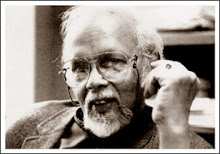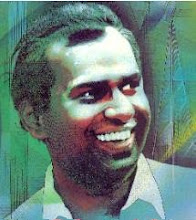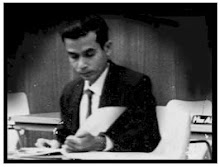Author:H.L.Seneviratne Source:Island Date:29/10/2003 Produced by Lalitha Sarachchandra

Lalitha Sarachchandra's production of Sinhabahu was staged at the St Anthony's College Hall, Katugastota on October 18, 2003. The production is worthy of detailed critical analysis. This is not such an analysis, but merely some random thoughts, on the myth, the play and on this production.
Sinhabahu is about love — between male and female, parent and child, and brother and sister. In the myth on which the play is based the male is not human but a lion. His habitat, the forest, signifies the opposite of orderly society and civilised life. The princess represents uncontrolled sexuality, and defiance of parental authority and social norms. The relation between the lion and the princess can also be seen as a variation of the cross-culturally familiar theme of a high born female`EDs desire for a non-conformist male of charisma and physical prowess, such as a bandit or a thief. Besides, we have in the myth a subterranean oedipal relation between mother and son, and father and daughter, replete with the son ultimately killing the father. Further, in the myth the love between siblings develops into an incestuous union. Thus, the myth is brimming with secret desires —bestiality, incest and parricide, major themes of our founding myth rarely remembered by nationalists. While the play explicitly deals only with the last, the subliminal presence of the other two cannot be denied, which is arguably the foundation of the subconscious appeal of the play.
Sarachchandra's play is a Buddhicisation of the myth. The sentiment of love, raw and wild in the myth, is romanticised and sanitised in the play. It is defined in renunciatory terms: its lure leads those smitten by it to abandon that which ordinarily they would cling to, such as wealth and power, palaces, finery, and bejewelled footwear.
This blissful state however 'begets sorrow', an idea that runs through all of Sarachchandra's major work and developed explicitly in Pemato Jayati Soko, and that ironically relates to the more conventional meaning of renunciation. Thus the overarching strategy of the play is first to build and then dismantle the edifice of love by bringing out dramatically its inevitable fragility and evanescence. This produces the pathos and what might be called the Buddhist catharsis of the play.
Three paths are used for achieving this artistic purpose. The first is the text with its unrivalled poetry and lyricism. The language of Sinhabahu is the finest since the days of the Guttila, the Kavyasekhara and the Sandesa poems, and while these classical works are solely poetic, Sinhabahu is dramatic as well. The second consists of the melodies, borrowed from what is left of the Nadagam repertoire after most of it was used up in Maname, with the rest composed with superb dramatic and musical imagination by H.H.Bandara. The third consists of (a) dance movements and mime and (b) choreography.
The text of the play is its soul and, as to be expected, remains unchanged in Lalitha Sarachchandra's production. So are the melodies, although some changes occur in music, for example at the Lion's entry, as noted below. It is in the realm of dance and choreography that this production most clearly exhibits its creativity and autonomy. Some of this is related to the greater professionalism and versatility of the actors available to Lalitha Sarachchandra as opposed to undergraduates who were the actors of Sarachchandra's original production. Costumes and make up, by the producer herself, are also two further areas of innovation.
Sarachchandra's production of Sinhabahu, like his Maname, did not remain static although much of what was changed would have been imperceptible to the ordinary theatre goer. Nor is it necessary for the theatre goer to know or notice any changes for purposes of his or her enjoyment of the play as a work of art. Sarachchandra's was a dynamic mind, and those who are familiar with how he worked would recall how eager he was to revise and renew, and seek new ways of making his work more effective theatrically and dramatically.
It is indeed this innovative gift and bent of mind that enabled him to come up with the first masterpiece Maname, and for all intents and purposes invent what is now considered a unique indigenous theatre which is also national in that it is accepted as the common heritage of the two major Sri Lankan ethnic groups Sinhala and Tamil.
Many imitations followed Maname, like the Kalagola Nadagama produced by some employees of Radio Ceylon as it was then known. These were at best monstrocities. The last thing Sarachchandra wanted to do was to repeat or imitate himself. As an artist, and a fervent anti-imperialist and critic of superficial westernisation, Sarachchandra sought to revive indigenous tradition, but he was never a purist or proponent of chauvinistic isolationism. Audiences would remember how in Kadavalalu, a short play that followed Maname, he introduced the hanamichi or the 'flower path' borrowed from the Japanese Kabuki theatre.
He was open to influences from anywhere, east or west, that would enrich his work. It would then not surprise us to find that he was interested in elements of Greek drama, which he used for the first time in his revisions to his original production of Sinhabahu. For example, he made the chorus and the actors enter from different positions on the stage. Further, in his original production, Sarachchandra had the chorus seated on a side on the stage, in Nadagam style, familiar to audiences of Maname. Not satisfied with this, he later placed the chorus in the back, facing the audience directly rather than at an angle. Besides, instead of male and female chorus members making an ungendered entry, he made the males enter from one side and the females from the other.
And instead of the chorus singing everything in unison all the time, he considered it was more effective at times to single out one voice. For example, during the father son battle, he made a single female voice sing the commentorial song 'vatuni sara bima met balen anga masa nosinda', deviating from both his first production and stage directions of his own text which specify that the song be sung by the chorus ('gayaka pirisa').
Lalitha Sarachchandra's innovation and achievement is her critical evaluation of these changes, and making a creative determination of her own as to which of the innovations added to the play's effect and which did not. For example, the arrival of the chorus from two directions and standing in front of the audience obstructed the arrival of the actors and interfered with the play's tempo. Besides, the simultaneous and prominent presence of a standing chorus and actors cluttered the stage with a cacophony of discordant costumes when viewed from the audience below. These technical and artistic considerations led Lalitha Sarachchandra to abandon those innovations that she thought were obstructive rather than conducive to greater effect. It is obvious that, since these were changes that Sarachchandra made to his original production, the abandonment of some of them constitutes a partial return to his original.
Instead of leaving the chorus passive and detached as in the original production, Lalitha Sarachchandra's seeks to enhance its visual presence at times, an innovation that reveals a subtle and creative understanding of the text`EDs complex meanings and dramatic potential. Thus when an actor left the stage at a mini climactic situation, she darkens the stage for a moment, focussing on the chorus, which continues the singing of the actor who just made his or her exit.
For example, when the princess makes the difficult decision to leave her lion husband and 'take the path that brings good to the two children' (daruvan dedena hata seta sadana), the producer first darkens the stage and then focuses lights on the chorus as it repeats the last lines of the princess' song. Thus, a particular dramatic moment in the development of the plot is underlined visually by the use of lighting, and aurally by using eight voices singing in unison replacing the single voice of the narrator.
Other innovations in this production are quite fascinating, giving the experienced theatre goer a feeling of a generally enhanced play. For example, the Lion is made to enter, not from the side of the stage as in the original production, but straight in front of the audience, through the back curtain, tearing it asunder, suggesting the dominance of the character in the play and foreboding the agonised lion`EDs later action of tearing to pieces those who dare to fight him. The Lion's movements, as well as those of other major male actors, especially Sinhabahu, are recreated in this production to bring out vigorous, assertive and potentially violent male power. The male dances are made more masculine (tandava), and the female movements more feminine (lasya). The Lion's entry is further enhanced and his brute power effectively evoked by the use of three drums, the Maha Davula, Podi Davula and the Maddalaya as well as cymbals.
This contrasts with the use of a single Maddalaya, as is usual in the Nadagam tradition, to indicate the appearance of all other actors. The Lion thereby comes through in a manner more credible and more worthy of his powerful textual visage. In another deviation from the original production, the love for each other shared by all four main characters is expressed in enhanced form by the use of more elaborate movements and gesticulation derived from classical Indian dance, composed imginatively by Miranda Hemalatha to suggest affectionate body contact. Taken as a whole it is clear that Lalitha Sarachchandra's production interprets, elucidates and expresses admirably the meaning and emotion of the text.
This is a healthy development that should be welcomed rather than condemned as a departure from orthodoxy. Indeed, it is the obligation of sophisticated audiences to expect and encourage talented future dramatic artists to come up with productions that would reveal their own creative interpretations which, one hopes, would depart from both the original of Ediriweera Sarachchandra and this production by Lalitha Sarachchandra.
No play can blossom without good actors. If the St Anthony's College Hall performance is an indication, the present production of Sinhabahu is fortunate to have an excellent cast all round. Jayanath Bandara as the Lion and Sunil Tilakaratne as Sinhabahu, both professionally trained dancers, gave exceptional performances. Witnessing the apparent ease with these actors sing and dance, it is easy to forget how exacting even merely physically their task is. But they did much more than physical exercise.
They sang with power, sonority and perfect control to fill a hall with less than perfect acoustics. And they danced with vigour and beauty in roles that left no respite. Nilakshi Rajivi Helapitiya as the princess gave a superb performance of the tragic heroine, combining outstanding expression and stage presence with elegance of voice. Pieris Samarawickrema as the Narrator, Sanath Vimalasiri as the Viceroy and Deepika Abeygunaratne as Sinhasivali gave skillful, memorable performances.
It was noted above that Sarachchandra borrowed freely from any source he thought was useful. But he was keen to indigenize the borrowed items or styles, and make sure that these served the artistic purpose of enhancing the play`EDs total effect. He was particularly touchy about what might be termed western popular culture in Sri Lanka, for example baila, and was only too aware that his early actors had a natural tendency to precipitate into what he called `ECbaila dance`EE.
He was always on the guard to exorcize any trace of that. The same applied to what he considered 'church singing', despite the fact that in his research on the folk drama he had identified this genre as one of the influences that went into the making of nadagam music. Perhaps it is precisely because he was aware of the contribution of choral church singing to nadagam music that he was keen to see that the connection remained historical. It is to the credit of Lalitha Sarachcandra's production that this precept is scrupulously observed: there is no church singing, and nobody does a baila dance.
(The writer is a professor of Anthropology at the University of Virginia, USA)




































No comments:
Post a Comment